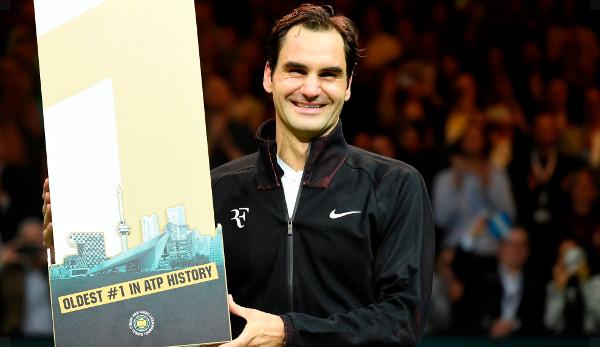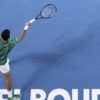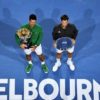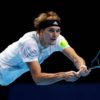Roger Federer has once again accomplished historic work. With his entry into the semi-finals at the ATP tournament in Rotterdam, the “Maestro” will be the oldest number one in history from Monday onwards.
He is no longer able to list all the records himself. Roger Federer has won everything there is to win in tennis. One time, several times. Or even eight times – like Wimbledon, the tournament of tournaments. He has won 20 majors so far, and just finished the round number at the Australian Open. He is much as a hunter of the best performances, also the perseverance miracle, the marathon man. He played 65 Grand Slams uninterruptedly and is thus unsurpassed. He also made 23 consecutive Grand Slam semi-finals. And he has been at the top of the world ranking for 302 weeks, 287 of them in series.
But has he put the crown on the whole thing, the hero of the whole sport world? When, on Friday evening in the Rotterdam Ahoy-Arena on Friday evening, he had defeated local hero Robin Haase in three sets of the quarter-finals and had become the oldest number 1 in tennis history, at 36 years of age and 195 days of age, Federer’s self-assessment was exactly that – the ultimate triumph, the record of records.
A seemingly impossible moment, come true only thirteen months after injury worries and an uncertain comeback,”This is perhaps the best moment of my career. Because I know what’s behind this success,”said Federer,”at this age you have to work twice for everything. This requires absolute discipline and dedication.”
When the computer world ranking list is published on Monday morning, it has a familiar picture, but it hasn’t been seen for years. Federer will then stand before Rafael Nadal, his eternal rival. It’s been more than five years since Federer was the last leader of the travelling circus – and if something seemed impossible, then this return to the top.
The conquest of first place is something like the supreme discipline of tennis, a hard effort over weeks and months, a massive test for psyche and body:”Becoming number one has nothing to do with luck or chance. It confirms that you play really good tennis all the time,”says Federer.
On this Rotterdam weekend, he himself looked back somewhat incredulously on everything he had achieved since the comeback at the beginning of the 2017 season – and what came to an end with the summit storm.”I didn’t expect anything from him. That makes it all the more beautiful. It’s really one big dream I’m living right now,”said Federer. It was also a dream because he had in the meantime, long before the injury problems of the year 2016, doubted further major successes.
When rivals such as Novak Djokovic and Andy Murray distanced him one by one and repeatedly beat him in big finals, Federer’s reputation was already in jeopardy and his reputation was damaged,”It was already a dry spell. But I haven’t really lost faith. I have been constantly remotivating myself,”said the Swiss.
Just like Andre Agassi, whom he replaced as the oldest No. 1 player, Federer experienced a late, miraculous renaissance – in his case even beyond the age of 35. Year of birth. Since he returned to the Australian tennis week last season, a story has unfolded that is ripe for hollywood – with the maestro in the excellent lead role. Federer won three of the four Grand Slams he competed in, twice in Melbourne and once in Wimbledon.
But he also won Masters trophies, winning favourite venues such as Halle – by the way, for the ninth time there. In 74 outings, he only left the court six times as a loser, a man in his thirties but juvenile, full of enthusiasm for the game.
His triumphs also have to do with Federer’s innovative power and inspiration. He has always reinvented himself, adapting his game to the needs of new tennis times. Especially in cooperation with Stefan Edberg, a grandmaster of the 90s, the Maestro received fresh impulses and strengthened his offensive power. In addition, there is a strategically perfect planning over many years of career, a correct dosage of appearances – and the art of renunciation.
He even skipped the entire clay court season in 2016 to preserve his substance for realistic title missions like in Wimbledon. Now, Federer managed to regain the number 1 position with only twelve tournament standings – although the ongoing injury tragedy among the top players also helped him, with Djokovic just as much as he did recently with Nadal.
The Spaniard will possibly return to tour operations at the end of February, at the competition in Acapulco. Because Federer will have to defend high scores in the next few weeks as the 2017 winners of the Indian Wells and Miami events, it is not unlikely that he will have to make room for Nadal again.
But the fact that he made it to the very late days once again to the very top is documented and sealed, no one can take that away from him anymore “He is the man who describes the whole tennis. The records are constantly being redefined,”says Agassi, the oldest to date. Just for comparison: Agassi was 33 years old at the time, Federer is now 36 years old.
If you want to better understand Federer’s tennis-cross-country skiing, his ultra-marathon, you just have to take a look at the world ranking list of January 2004 – the moment when the 22-year-old Swiss rider climbed the summit for the first time at the Australian Open. None of the players who were in the top ten at that time are still active as professionals.
Former competitors such as Juan Carlos Ferrero or Carlos Moya are now training Federer’s current top opponents – Ferrero works for Alexander Zverev, Carlos Moya for Rafael Nadal. Andy Roddick, Agassi, Rainer Schüttler, David Nalbandian or Mark Philippoussis – they are all tennis pensioners long ago. Only Federer’s still here. Still and always great.














You must be logged in to post a comment Login